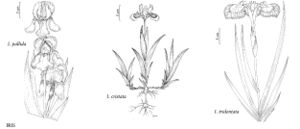Iris pallida
in J. Lamarck et al., Encycl. 3: 294. 1789.
Rhizomes branching, forming extensive clumps, 1.5–2 cm diam., smooth except for narrow leaf scars that completely encircle rhizome. Stems 1–3-branched, 6–10 dm. Leaves erect to spreading, blade green (some forms with white or yellow longitudinal stripes), ensiform, 3–6 dm × 3–4 cm, very glaucous, smooth. Inflorescences with terminal unit 3-flowered, branch units 2–3-flowered; distal branches subtended by scarious bracts, lower one to 15 cm, herbaceous, green; spathes completely silvery white, 2–3.5 cm, scarious. Flowers often very fragrant; perianth light blue-violet to mauve-purple, one form with blue pigment limited as stipples or stitches along margin and/or along veins, with ground color white on both petals and sepals; floral tube 1–1.3 cm; sepals slightly reflexed, obovate, 7.8–8.3 × 5–5.3 cm, with wedge-shaped claw marked with brown veins, beard yellow with white tips; petals blue-violet, in some forms lighter than sepals, with some brown veining at base and on claw, obovate, 8 × 5 cm; ovary trigonal, 6-grooved, 1–1.5 cm; style violet, fading paler along margins, keeled along midrib, 2–2.4 × 1 cm, crests rounded, 1.4 cm, apex acute; stigmas rounded, margins entire; pedicel very short, 2–3 mm. Capsules borne on ends of stems and branches, oblong, trigonal, 6-grooved, 4–5 × 1.5–2 cm. Seeds in 2 rows per locule, dark brown, compressed, cubical, wrinkled. 2n = 24.
Phenology: Flowering Apr–mid Jun.
Habitat: Widely cultivated and often persisting around old dwellings
Distribution
Calif., Ga., Ind., Mo., Europe.
Discussion
Iris pallida is considered to be one of the parents of I. germanica, to which it contributed blue pigment (delphinin) as well as the recessive white allele responsible for white-flowered forms. It also contributed the recessive distribution-pattern allele that limits the blue pigment to veins and to stipples or larger dots along the margins of the petals and sepals, the plicata pattern so popular in the garden today.
Selected References
None.
